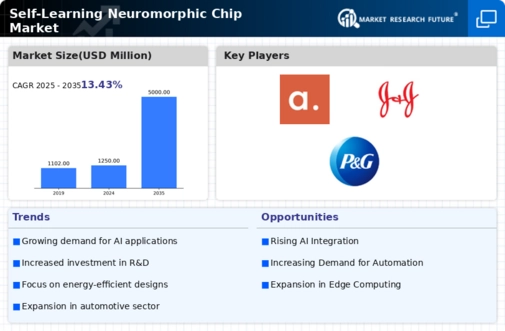Increased Investment in AI Research
The self learning-neuromorphic-chip market benefits from increased investment in artificial intelligence research and development. Both private and public sectors are channeling substantial funds into AI initiatives, recognizing the transformative potential of neuromorphic computing. In 2025, it is estimated that AI-related investments in the US will surpass $50 billion, with a significant portion allocated to developing neuromorphic technologies. This influx of capital fosters innovation and accelerates the commercialization of self learning-neuromorphic chips, enabling companies to bring cutting-edge solutions to market more rapidly. Furthermore, collaborations between academic institutions and industry players are likely to enhance the research landscape, driving advancements in neuromorphic chip capabilities. As investment continues to rise, the self learning-neuromorphic-chip market is poised for robust growth, reflecting the increasing reliance on AI across various sectors.
Emergence of Edge Computing Solutions
The emergence of edge computing solutions significantly impacts the self learning-neuromorphic-chip market. As organizations increasingly adopt edge computing to process data closer to the source, the demand for efficient and powerful chips rises. Neuromorphic chips are particularly well-suited for edge applications due to their low power consumption and high processing capabilities. This trend is expected to drive market growth, as companies seek to deploy AI solutions that can operate effectively in decentralized environments. By 2026, the edge computing market is projected to reach $20 billion, with a substantial portion attributed to the integration of neuromorphic technology. The self learning-neuromorphic-chip market stands to benefit from this shift, as it aligns with the growing need for localized data processing and real-time analytics.
Rising Demand for Advanced AI Solutions
The self learning-neuromorphic-chip market experiences a notable surge in demand driven by the increasing need for advanced artificial intelligence solutions across various sectors. Industries such as healthcare, automotive, and finance are actively seeking innovative technologies to enhance their operational efficiency and decision-making processes. The market is projected to grow at a CAGR of approximately 25% from 2025 to 2030, reflecting the urgency for sophisticated AI capabilities. As organizations strive to leverage data analytics and machine learning, the self learning-neuromorphic-chip market becomes a pivotal component in developing intelligent systems that can learn and adapt autonomously. This trend indicates a shift towards more complex AI applications, necessitating the integration of neuromorphic chips that can process information in a manner akin to human cognition.
Technological Advancements in Chip Design
Technological advancements in chip design significantly influence the self learning-neuromorphic-chip market. Innovations in materials and fabrication techniques enable the development of chips that are not only more efficient but also capable of processing vast amounts of data in real-time. For instance, the introduction of 3D chip architectures and advanced semiconductor materials enhances the performance and energy efficiency of neuromorphic chips. As a result, the market is witnessing a transformation, with companies investing heavily in research and development to create next-generation chips. This focus on innovation is expected to propel the market forward, with estimates suggesting a market value exceeding $10 billion by 2030. The continuous evolution of chip technology is crucial for meeting the growing demands of AI applications, thereby solidifying the self learning-neuromorphic-chip market's position in the tech landscape.
Growing Need for Real-Time Data Processing
The self learning-neuromorphic-chip market is propelled by the growing need for real-time data processing in various applications. As industries increasingly rely on data-driven decision-making, the demand for chips that can process information instantaneously becomes paramount. Neuromorphic chips, designed to mimic the human brain's processing capabilities, offer a unique solution to this challenge. They enable faster and more efficient data analysis, which is critical in sectors such as autonomous vehicles, smart cities, and IoT devices. The market is expected to expand as organizations seek to implement systems that require immediate data interpretation and response. This trend highlights the importance of self learning-neuromorphic chips in facilitating advanced analytics and enhancing operational efficiency, thereby solidifying their role in the evolving technological landscape.













Leave a Comment